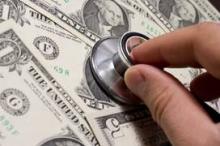WASHINGTON – The historically low growth in health spending in 2009 and the first half of 2010 continued through the end of 2010*, driven largely by the recession, Centers for Medicare and Medicaid officials announced Jan. 9.
U.S. health spending grew 3.9% in 2010, to a total of $2.6 trillion or $8,402 per person. That was a 0.1% rise from 2009, which was already at an all-time low growth rate.
As the nation’s economy slumped throughout 2009 and 2010, consumers cut back on elective surgical procedures, emergency room visits, physician office visits, and prescription drug use, according to the officials.
"Even though the recession officially ended in 2009, its impact on the health sector appears to have continued into 2010," said Anne Martin, an economist with the CMS.
Employers shifted the costs of insurance and care to employees, which drove up out-of-pocket spending in 2010. But consumers overall spent only 1.8% more out-of-pocket in 2010 than they had in 2009, which was a slow rate of growth when compared with historical patterns, Ms. Martin said.
Consumers reacted to cost-shifting by choosing health insurance plans with lower premiums and higher deductibles, and by reducing, where they could, use of personal health care services. Medical prices and the U.S. population remained relatively stable before, during, and after the recession, and yet, personal health spending fell, indicating a willful pullback.
"The slower growth in personal health care spending was mainly driven by the slowdown in the use and intensity of health care goods and services," Ms. Martin said. The agency documented a shrinkage in use of hospital care and physician services as compared with historical levels.
Hospital spending grew only 5% to $814 billion in 2010, compared to 6% in 2009. There was a decline in median inpatient admissions, and slower growth in emergency department visits, outpatient visits, and outpatient surgeries.
Overall spending on physicians and clinical services – totaling $515 billion in 2010 – accounted for 20% of total health spending. As consumers went to the doctor less frequently, fewer prescriptions were written. And, many of those dispensed were for less expensive generic drugs. These and other factors led to the slowest rate of growth in prescription drug spending ever recorded – a 1% increase from 2009 to $259 billion. The data were published in the journal Health Affairs (Health Aff.2012 [doi: 10.1377/hlthaff.2011.1135]).
Growth in spending on physician and clinical services also was historically low, growing 2.5% in 2010 as compared with 3.3% in 2009, said Ms. Martin.
Meanwhile, as employers and private insurers reduced the amount they spent on health care, the federal government’s share of health spending rose – to 29% or a total of $742 billion in 2010. The rise in federal spending also was attributed to federal subsidies to state Medicaid programs. Medicaid was about 15% of the nation’s health bill in 2010, at $401 billion.
In 2009, the federal government spent 22% more than in 2008; in 2010, spending rose by almost 9%. That compares to a 10% decrease in spending by states and localities in 2008, and a 4% increase in 2010.
Medicare saw an increase in enrollment, both in Medicare Advantage managed care program and traditional fee-for-service Medicare. The increase in traditional enrollment reversed a several-year pattern of decline. Overall, Medicare spending increased 5% in 2010 to $524 billion, but per-enrollee spending did not rise as quickly as it had in 2009.
This is because there was a big reduction in payments for certain types of home health services, but also because of low use of physician services. Small increases in physician fees in 2009 and 2010 also kept a lid on Medicare spending.
Those increases were instituted by Congress in response to cuts that would otherwise have been required by Medicare’s Sustainable Growth Rate formula.
The Affordable Care Act had a negligible impact on overall spending, perhaps accounting for less than 0.1% of the slowdown, according to the CMS economists. This is because few provisions were in effect in 2010, and some, such as coverage for patients with preexisting conditions, did not enroll as many people as had been expected.
*Correction, January 19, 2012: An earlier version of this story misstated the years covered by the reported data.


